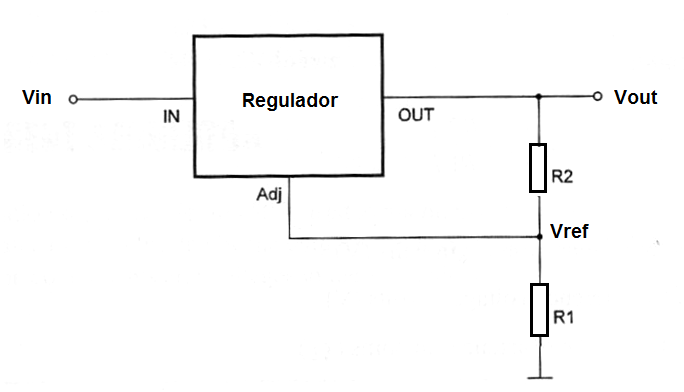The basic configuration of a three-terminal voltage regulator is shown in figure 1. Vin must be 2 or more volts higher than the input voltage and R1 is normally given by the manufacturer.

Formula 1
Output voltage:
Vout = Vref x [ 1 + (R2 / R1) ] + Iadj x R2
Where:
Vout is the output voltage in volts (V)
Vref is the reference voltage in volts (V)
R1 and R2 are the resistances in ohm (Ω)
Iadj is the adjustment current in amperes (A)
Note: a) for the adjustable regulators Uref is normally the minimum output voltage. For instance a 1.2 to 33 V IC has a Uref of 1.2 or 1.25 V (the internal zener diode)
b) In practical cases the term IdjxR2 is very low when compared with the other term in the formula so it can be disconsidered withtout affecting pratical results in a project. See next formula:
Formula 2
Simplified formula:
Vout = Vref x [ 1 + (R2 / R1) ]
Where:
Vout is the output cvoltage in volts (V)
Vref is the reference voltage in volts (V)
R1 and R2 are the resistances in ohm (Ω)
Application example:
Calculate R2 when using a LM150 in a power supply for an output of 12 V. R2 is 240 Ω and Vref is 1.25 V.
Data:
Vout =12 V
Vref = 1.25 V
R1 = 240 Ω
R2 = ?
Using formula 2:
Vout = Vref x [ 1 + (R2 / R1 ) ]
12 = 1.25 x [ 1 + (R2 / 240 ) ]
12 = 1.25 x [ (240 + R2 ) / 240 ]
12/1.25 = (240 + R2) / 240
Isolating R2:
R2 + 240 = (12 x 240) / 1.25
R2 = 2304 -240
R2 = 2064 Ω




